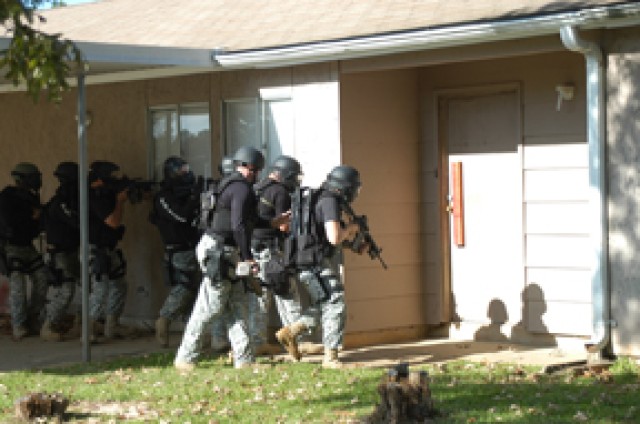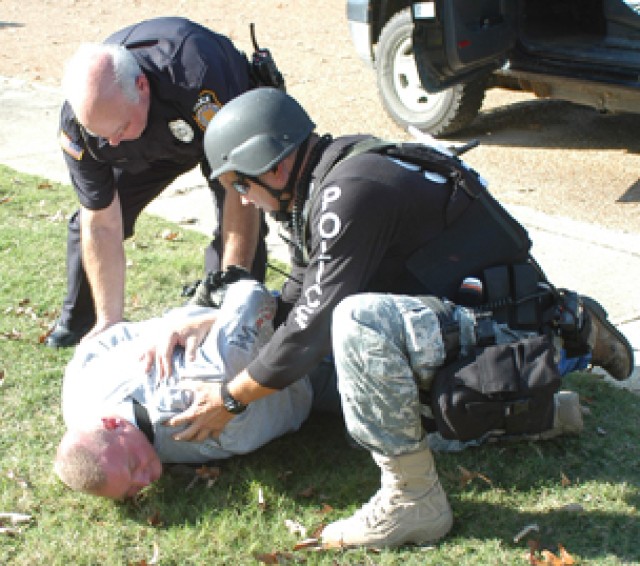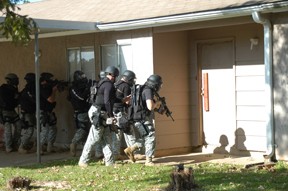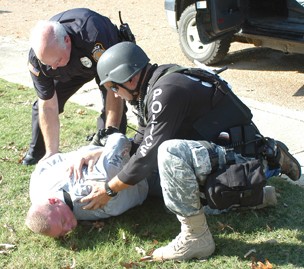FORT POLK, La. -- The shootings at Fort Hood, Texas, Nov. 5, which left 13 Soldiers and civilians dead and dozens wounded, probably raised questions for many Soldiers and Families across the Army. Could the same violence occur at Fort Polk' Would the police and other emergency agencies react quickly enough to minimize the number of casualties'
Months before the Fort Hood tragedy, Fort Polk's Directorate of Emergency Services coincidentally planned a simulated hostage standoff training scenario for Nov. 9. While the two events were completely unrelated, the Fort Polk police officers approached their training with added gravity.
"It's coincidence that we conducted our training around the same time as the shooting," said Capt. John Ferrell, Provost Marshal's Office. "Fort Polk police and Special Reaction Team have had plans in place for a long time for any type of situation that could arise. They're fully prepared to answer any threat. This training just reinforces it."
The training took place in empty housing units on Fort Polk and involved several emergency agencies. "We do this type of scenario training semi-annually and involve the road patrols and SRT," Ferrell said. "That way everyone benefits from the training. This is the culminating event for each of the different sections' training. We have roleplayers, Fort Polk Fire Department treating casualties, Criminal Investigation Division providing hostage negotiation, patrols doing immediate response and SRT does their reaction drill. Everybody is working together as a team -- this is as life-like as we can get it."
First Lt. Nathaniel Schuhart, DES, planned the training. "For the scenario, I thought of something that could actually happen in real life," he said. "It's based on a husband who was deployed and reacted violently when he discovered his wife was cheating on him."
When the first police officers arrived on the scene, several roleplayers were lying around the street wounded and some were running around panicked. The officers calmly formed a perimeter and learned the suspect was barricaded in a nearby house. Three policemen breached the house and eliminated the suspect, while one officer tended to the casualties. "In the first scenario they took out the hostage-taker and the wife and baby both survived, so it ended up quite well," said Ferrell. "They felt that was the action they had to take."
Schuhart agreed: "They didn't hesitate."
The scenario was reset, and the patrol officers formed a perimeter to wait for the SRT. Until the SRT arrived, a hostage negotiator reached the suspect via cell phone. When the SRT got to the scene, in full tactical regalia, the negotiator obtained the release of the hostage infant. Four SRT members retrieved the simulated "child" from a window. After the SRT regrouped, the team breached the house and resolved the situation.
"You can never create the same stress that would be present in a live shooting scenario, but this does test the officers," said Ferrell. "They all have 'simunitions,' so anyone who gets shot will actually be hit by a practice round.
"There are no two shooting situations alike; there are no two police calls alike. There is no way for a patrol to know exactly what they're going to do. I think they did well. The patrol supervisor created perimeter security, cordoned off the area, and waited for the SRT to arrive."
The ultimate result of the event was a myriad of lessons learned. "Everyone involved today learned lessons," said Officer Mike Martin, DES. "I've been in law enforcement for more than 20 years, but you never get too old to learn something. The good thing about this is we can critique each other -- the fire department saw things we shouldn't have done, and we have some pointers for them, too."
"Now we know some of our rough spots. This will only make us better," said Sgt. W.L. Bynog Jr., SRT. "We can never be perfect, but it's better to learn these lessons now than in a live situation."
Fort Polk can rest easy knowing DES is prepared to meet any challenge. The team is adaptable, too. "This is a continuous learning process, even during the after action review," said Schuhart. "Everyone will benefit from this. We'll incorporate our rough spots into our next training events."




Social Sharing